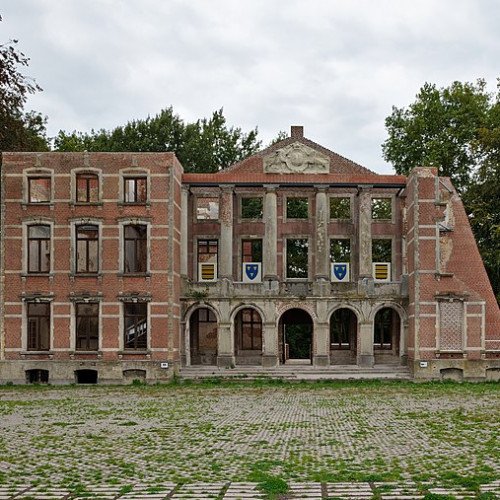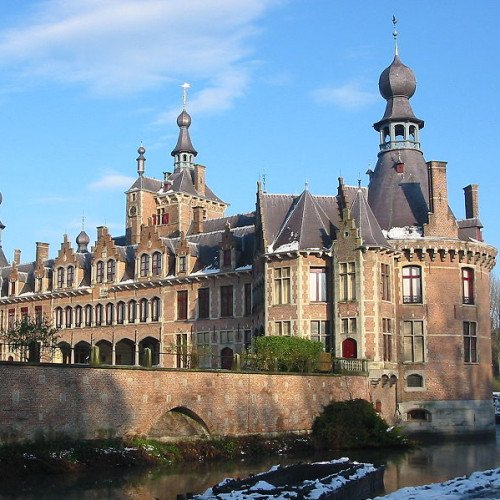Castles of "Belgium" MESEN CASTLE vs OOIDONK CASTLE

MESEN CASTLE
Mesen Castle was an important noble residence in Lede, Belgium, today partly ruined and completely abandoned. The 18th century castle is considered to have been one of the most important aristocratic estates of the 18th century. Originally the vast estate and castle were private owned by the Marquess of Lede. Among the castle's residents were Françoise de Bette and Jean François de Bette, 3rd Marquess of Lede. The 18th-century facade was designed by the Italian architect Giovanni Niccolò Servandoni for the 4th Marquess, Emmanuel de Bette. It is considered one of this architect's major works. The main facade has a dorian colonnade with balustrade and large pediment, with heraldic crest of the house of Bette, holding lions.After the noble house became extinct, the property was bought in 1897 by a Catholic institution and had an important social function. New buildings were added in Neogothic style. From 1914 to 1970, the castle became a boarding school for girls. Institution Royale de Messines moved to the Mesen Castle after the First World War. There were approximately 150 girls from 5 years old to 18 years old that studied in french at the 'Pensionnat de Lede' from 1914 to 1970. The school was for daughters of men in the military after the First World War. It was a very good school managed by very strict laic ladies where girls learned French, Flemish Dutch, arithmetic, gymnastics, theatre, cooking, good manners, painting, and sewing. The girls and ladies lived together in a very close community, leaving only for Christmas, Easter and summer vacations, and having visitors once a month.
Statistics for this Xoptio

OOIDONK CASTLE
Ooidonk Castle (Dutch: Kasteel Ooidonk) is a castle in the city of Deinze, East Flanders, Belgium. The castle is the residence of the current Count t'Kint de Roodenbeke. Ooidonk Castle is situated at an altitude of 11 meters. Ooidonk is already mentioned in 1230 : "Nicolas, chaplain of Hodunc". A fortress was first built on the site of the current castle, intended to defend the city of Ghent and to fortify the river Leie. This fortress was owned by Jean de Fosseux, lord of Nevele. The castle was destroyed for the first time in 1491 by the people of Ghent in revolt against Maximilian of Austria. In 1568, Philippe II de Montmorency-Nivelle, Count of Hornes, Lord of Nevele and owner of the estate was beheaded, along with the Count of Egmont, by the Duke of Alba in Brussels. In 1579, during the wars of religion, the castle, defenseless, was destroyed by the Ghent Calvinists. The ruins and lands were later acquired by Martin della Faille, a notable merchant from Antwerp. He rebuilt the castle in a Renaissance style and transformed it into a place of residence in Hispano-Flemish style. In 1864, the castle and lands were acquired by Henri t' Kint de Rodenbeke who went on to become President of the Senate and Minister of State. He restored and transformed the castle. It is now the private property of Count Henry t'Kint de Roodenbeke, son of the late Count Juan t'Kint de Roodenbeke. In 1944, the castle was classified as a protected landmark. In 1980, other constructions around it were also classified, and in 1995, so was the rest of the estate. Ooidonk Castle is open to the public from April 1 to September 15, and the park (with its French garden) can be visited year round.